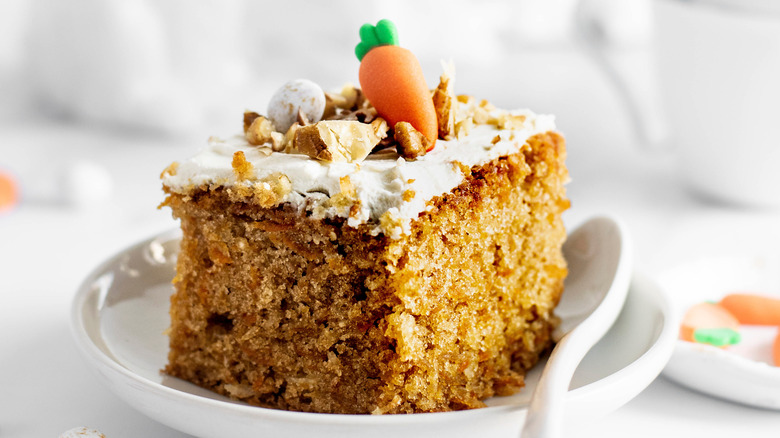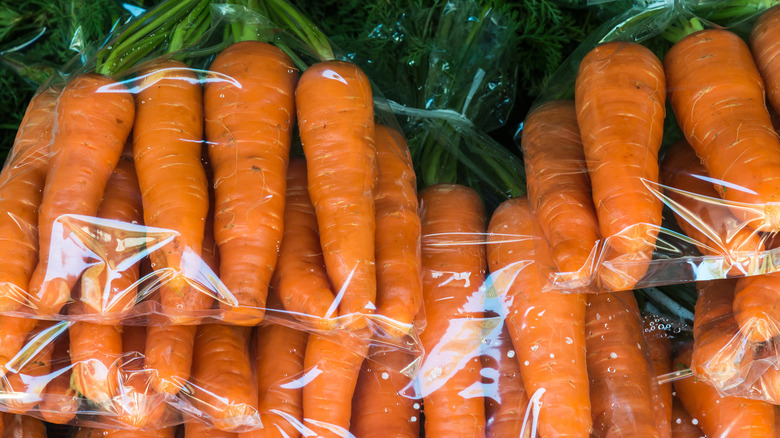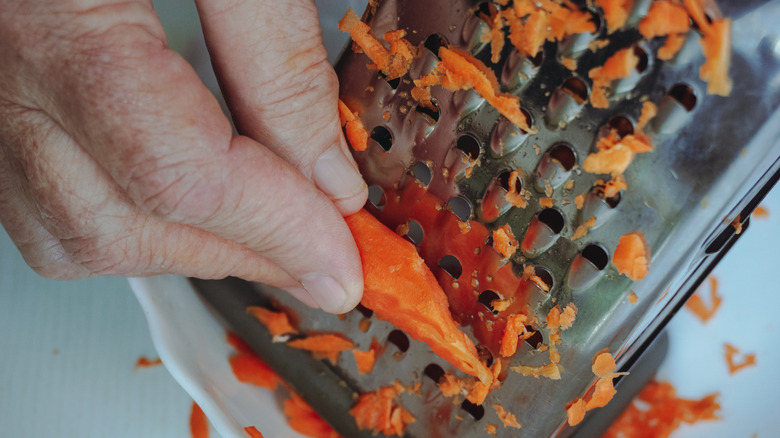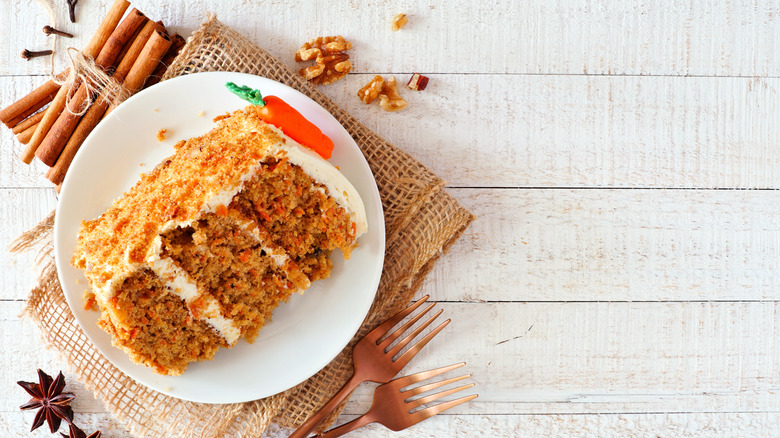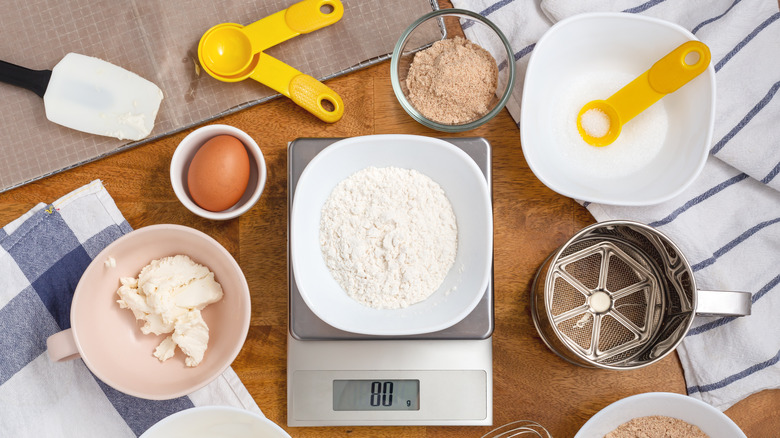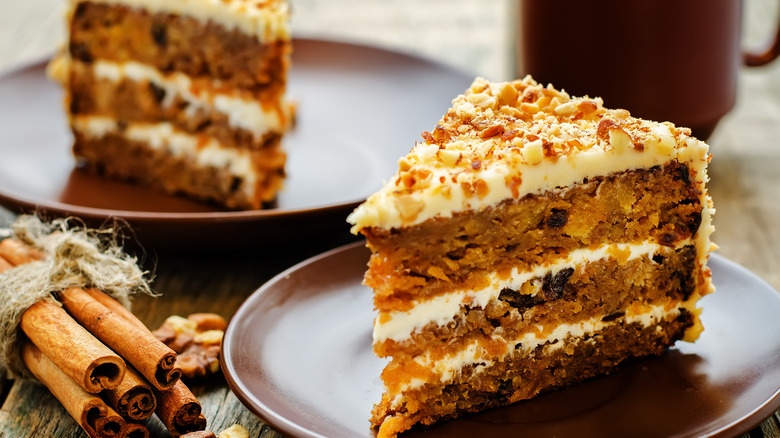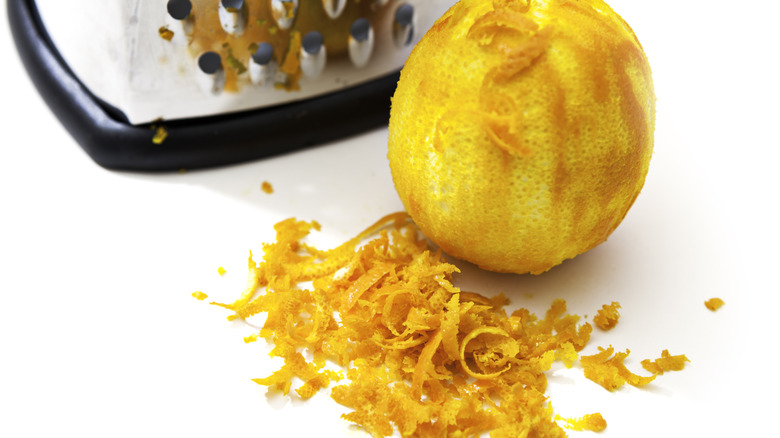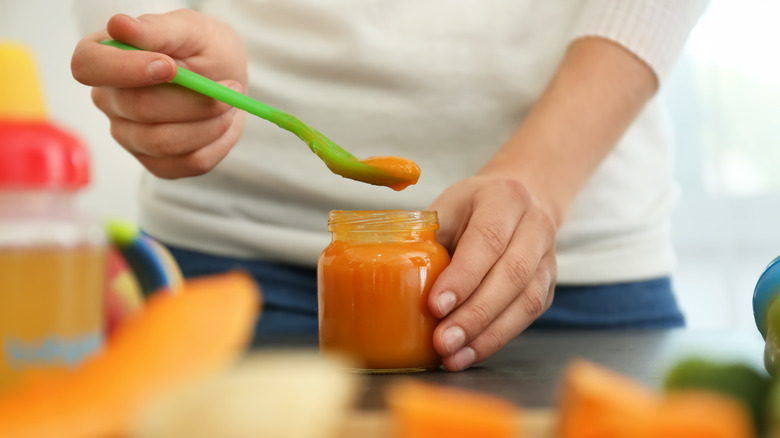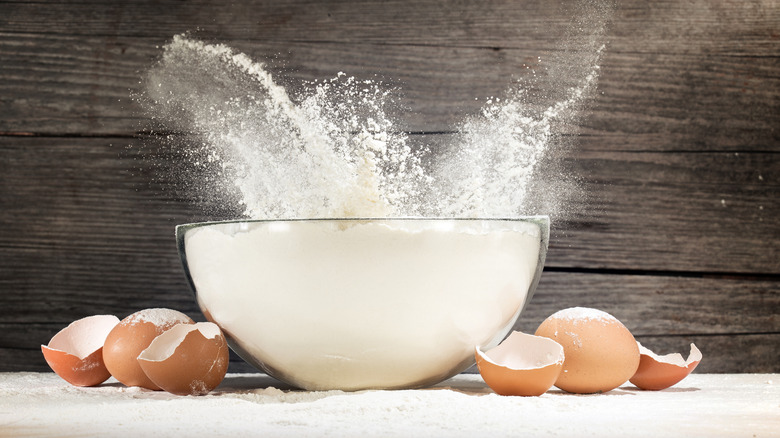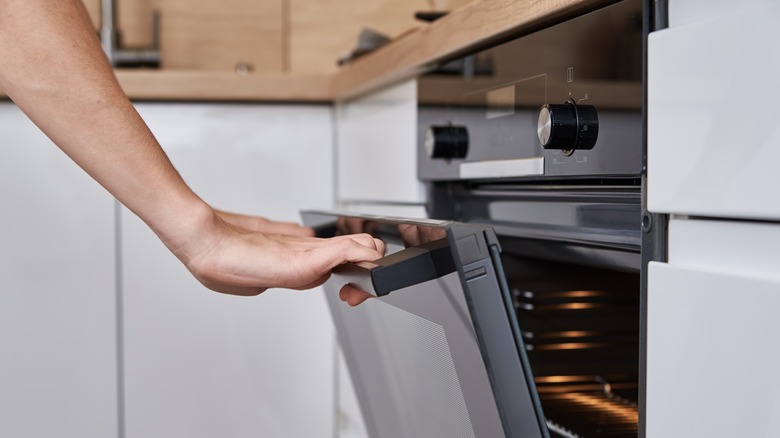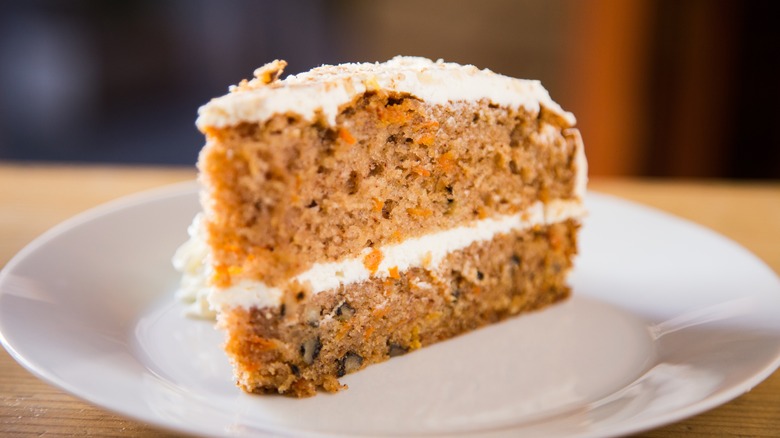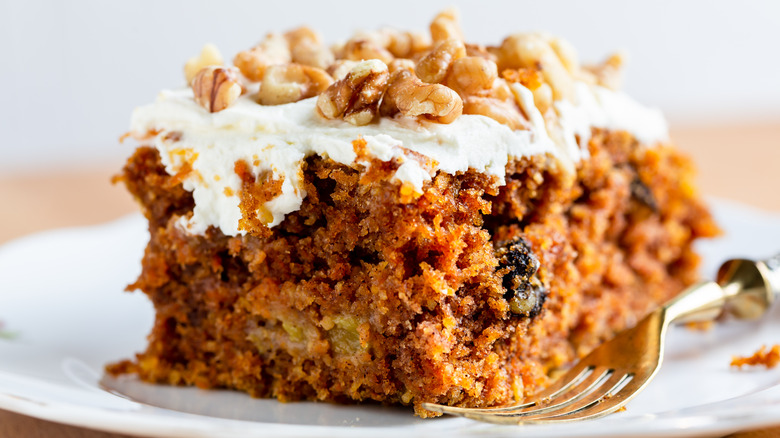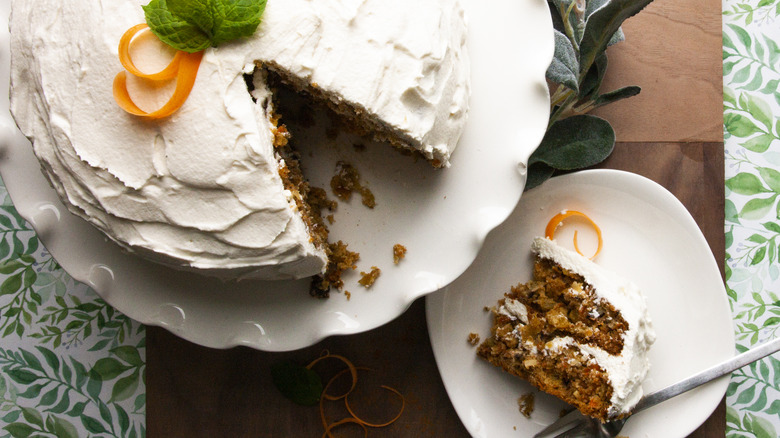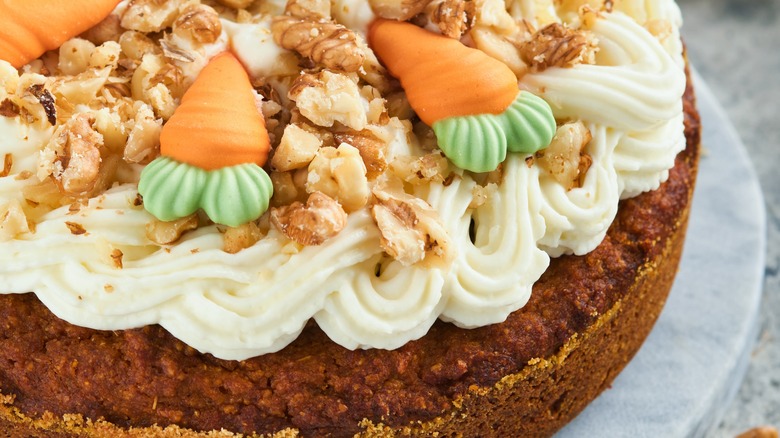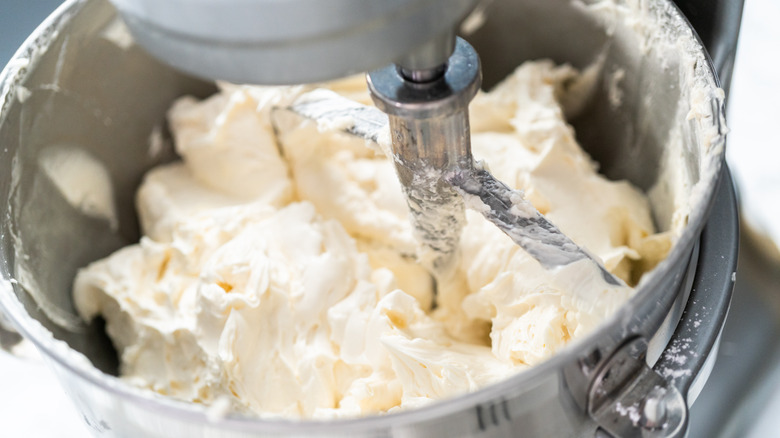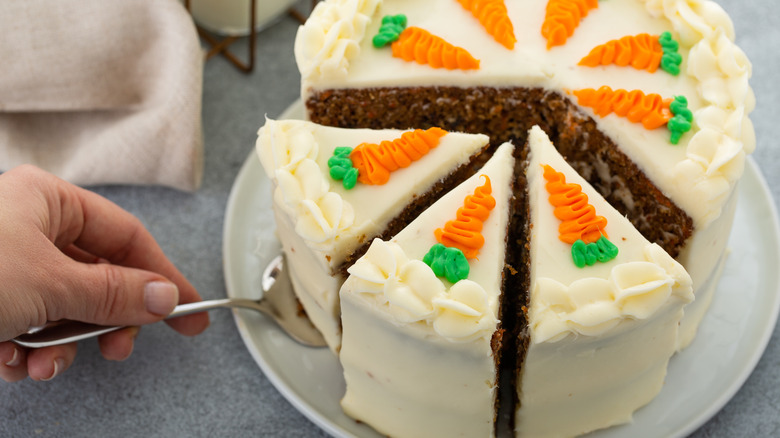16 Mistakes To Avoid When Making Carrot Cake
Carrot cake is one of the most delicious springtime-inspired desserts you can eat. This cake gets its moisture from adding grated carrots to the batter; it's traditionally topped with a decadent layer of cream cheese frosting. Carrot cake can include other fruits and nuts like walnuts and raisins depending on your recipe.
The first carrot cake recipe appeared in a French cookbook in 1827, but the cake only surged in popularity in the second World War in the 1940s. During this time, the English set rations on sugar, thus leaving home bakers to seek alternative ways to sweeten their puddings, cakes, and pies. The pairing with cream cheese frosting didn't occur until the 1960s.
Making carrot cake is a deceptively easy experience. You must follow many steps to ensure that the cake remains moist, spiced, and flavorful rather than dry and dull in flavor. Here are some of the most common mistakes people make with carrot cake, along with how to avoid making them.
Using old carrots
Believe it or not, there are right and wrong carrots to use for your carrot cake. The perfect carrots to use for baking are sturdy, strong, and do not show any signs of mold or spoilage. To check the age of a carrot, perform a snap test by bending the carrot. If you can bend it more than 45 degrees to any side without snapping, the carrot isn't fresh enough to bake with.
While you can use baby carrots for baking, you should expect to struggle a little bit more with grating them since they're so small. Also, you should avoid using pre-shredded or frozen carrots to make your carrot cake because these products don't have the same moisture, texture, or freshness as whole carrots.
Our favorite carrots to use for carrot cake are any variety with a bright orange or red hue. These colors indicate high lycopene levels, a pigment and an antioxidant, which also suggests that a fruit or a vegetable is high in sugar.
Grating your carrots too large
It wouldn't be carrot cake without the carrots, right? Carrot cake recipes typically use grated carrots, which can be grated down using a box grater or a food processor with a shredding disc. A food processor is a good tool if you need a lot of carrots for your recipe, but the shredding disc won't grate the carrots finely enough for maximum utility.
Always use the smallest hole size if you use a box grater to grate your veggies. This will give you the most amount of moisture when you go to bake the cake. To use the box grater, ensure the carrots are first cleaned and peeled. Leaving a bit of stem on the end of the carrot is helpful so your fingers won't get too close to the sharp blade. Next, rub the carrot downward against the grater, stopping before your knuckle touches the tool.
Being skimpy with your spices
Although the star of the show is the carrot, carrot cake is inherently also a spice cake. This means you have to get creative with the spices you add to the mix to add a bit of heat and flavor to your dessert. The most common spices found in carrot cake are warming spices like cinnamon, nutmeg, and cloves. But chef Ina Garten elevates her carrot cake with the addition of candied crystallized ginger. She adds this ingredient, which is made by candying ginger in simple syrup, to a mascarpone cheese frosting.
If you want to add a slight bit of heat to your carrot cake, you can also add a bit of ground ginger to the cake batter with the rest of your spices. Just beware that ground ginger can pack a powerful flavor punch, and adding too much can upset the delicate flavor balance you worked so hard to create.
Not using a scale
One of the most common mistakes people make with baking is not using a digital scale to measure their dry ingredients accurately. You should bake with a scale because not all cups and scoops are alike. Did you press the scoop against the side of the flour bag? Or did you pack down your brown sugar into your measuring cup? What about forgetting to level off your baking powder? All of these stylistic differences in food preparation can impact how accurate your measurement is. Whereas, if a recipe calls for 100 grams of flour, you really can only mess it up if you forget to tare your scale.
There are many consequences to incorrectly measuring your dry ingredients, including a cake that comes out dry or a cake that resembles more of a pudding. And since a kitchen scale can cost you less than $10, there's really no reason not to have one in your aresenal.
Adding too many mix-ins to your batter
Carrot cake is a blank canvas of flavors, which is why we love baking it. If you want to add golden raisins, chopped pecans, or prunes, you can easily scoop them into your cake batter and transform the flavor of your cake. You should consider adding fruit to your carrot cake for an added boost of fiber, antioxidants, and taste, too.
But there comes the point where adding more mix-ins will do more harm than good. If you add too many mix-ins, you can dull the spicy flavor of the cinnamon and the nutmeg, or if you add wet ingredients like pineapple, your cake will come out too soggy and fall apart. The grated carrots provide enough moisture to moisten the cake, so avoid any additions that might push your dessert over the edge and into pudding territory. Instead, chop your nuts and dried fruit into small pieces and add as much to the batter as the recipe recommends.
Omitting citrus
One of the most valuable ingredients in carrot cake is citrus. It breaks up the monotonous, sweet taste of both the frosting and the cake, and it can challenge some of the dominant flavors and spiciness of the batter. To make our orangey carrot cake, we add the zest of one orange to the batter with the grated carrots and ¾ teaspoon of orange extract to the frosting for a little extra bite. However, we recommend being very careful with measuring the orange extract since it is easy to overpower the frosting with it.
You can also incorporate orange into your carrot cake as a garnish. Candied orange peels can be made with three ingredients: oranges, water, and granulated white sugar. First, peel the orange using a standard vegetable peeler and slice it into ¼-inch pieces. Then, boil and rinse the peels before simmering them in the simple syrup for at least an hour. Once you've removed the peels from the syrup, you can dry them and sprinkle them atop your homemade carrot cake.
Not trying to use jarred baby food
This next trick might seem a little odd, but we can attest to the fact that it does work. Jarred baby food is the unconventional ingredient swap to make carrot cake so much easier. Using just two jars of carrot-flavored baby food instead of shredded carrots can keep your cake super moist and take the work out of shredding your carrots by hand. You'll want to use eight ounces of baby food for every two cups of flour in your recipe. Add the baby food to the batter with the oil, eggs, and any other wet ingredients you plan to add to your cake.
If you can't find carrot-flavored baby food in your local grocery store, you can use a medley of fruit-flavored baby foods instead. Pairing carrot baby food with apricot, apple, or sweet potato baby food flavors are simple ways to infuse more moisture into your cake while also getting some more fruit and veggies onto your plate.
Using butter instead of oil
Carrot cake is a dense, moist cake. Food personality Duff Goldman recommends using oil over butter in a carrot cake. He uses over two cups of vegetable oil in his own carrot cake recipe and recommends that home bakers do the same. He claims using oil over butter will keep the cake moister; this same theory is also rooted in science. Vegetable oil remains liquid at room temperature, while butter solidifies. This is why room-temperature cakes made with oil appear moister and will also stay soft and plush if left on the countertop overnight.
Using oil in a cake will also increase its tenderness compared to butter. Gluten is the agent in the cake batter that can make it tough and dense. Since gluten is activated with water, adding a fat like butter, which contains about 20% water and 80% fat, opens up the opportunity for more troublesome gluten formation. Oils are made with pure fat, thus limiting gluten formation, making the cake fall-apart-in-your-mouth delicious.
Only using white flour
Cake recipes often call for all-purpose flour or cake flour, which has slightly less gluten. But there are many opportunities for flavor and nuttiness through using different flour types in your cake recipe. For example, we recommend using whole wheat flour to complement the nuttiness of walnuts or pecans in your carrot cake. Since whole wheat flour has slightly less gluten than all-purpose flour, you can blend it with equal parts all-purpose to create a custom flour blend for your cake recipe.
Spelt flour is another flour type with a mild, slightly sweet flavor and impressive nutritional profile. However, you'll need to take some special care in working with spelt flour because its high gluten content does not always make it easy to replace with all-purpose flour. Spelt flour also won't absorb liquids as readily as all-purpose or whole wheat flour, so you should try to use spelt and a more standard type of flour together to develop the perfect texture for your carrot cake.
Underbaking the cake
One of the most common mistakes everyone makes with cake is underbaking it. Since carrot cake is naturally moist and brown in color, many cooks remove the cake from the oven prematurely, thinking it's finished baking — when in reality, it's entirely raw inside. Instead, you should bake the cake at the temperature and the time listed in the recipe, taking into account the size of the pan (cupcakes bake faster than cake) and its color (dark pans tend to absorb more heat and bake quicker than lightly-colored pans).
Opening and closing your oven too often during baking can also create major structural issues in the cake and require it to bake longer than expected. Therefore, you should keep the oven closed for at least 75% of the time that your cake is in the oven and only check the progress of your cake at no less than five to 10-minute intervals.
Baking too many layers
Carrot cake has many variations, including cupcakes, sheet pan cakes, and layer cakes. If you go the layer cake route, you should be careful to make only a few layers since the carrot cake is very dense and heavy. The texture of the cake also works against you if you're planning on slicing the cake rounds to double your layers. So instead of baking two rounds, cooling them, and cutting them into four separate layers, you should stick with making three smaller rounds and stacking those on top. That way, you won't have to worry about pesky raisins getting in the way of a perfect layer slice.
If you want to make an impressive stack that has some stability to it, you may consider using dowels. These dowels will help support the weight of the cake without putting all the pressure on the bottom of the cake. Plastic, PVC, or wooden dowels, or even clean boba straws, can help add some structural stability to a heavy carrot cake.
Frosting your cake while it's warm
You should never frost cakes before they cool because it may cause the melting frosting to fall apart instead of staying on your cake. Since most frostings are made of fat, including the decadent cream cheese frosting that is often paired with carrot cake, any exposure to heat may cause your icing not to spread evenly and may also break at the exterior – meaning that the cracks and dents in your cake will be more visible. Instead, wait about two or three hours for your cake to fully cool before slathering on the frosting.
If you want to expedite the cooling process, you can also resort to putting your cake in the refrigerator. Bring the cake down to room temperature so it's not steaming hot right out of the oven, and wrap it in plastic wrap to seal in the moisture. If needed, you can leave the cake in the refrigerator or even the freezer for a few days.
Not using a crumb coat
If you want to make a carrot cake with all the decorating bells and whistles, you'll need first to apply a crumb coat to your cake. A crumb coat is a thin layer of icing applied to the cake after cooling and before the other layer of decorative frosting is used. It has many jobs, including capturing the specks of cake that would otherwise make your icing grainy and filling in any extra holes on the outside of your cake that could potentially make your frosting job look patchy.
To crumb coat a cake, you'll want to start by cooling the cake completely. Then, add a thin layer of frosting onto the cake and use a bench scraper or spatula to spread it evenly around each layer. You'll want a second bowl handy to wipe off the crumbly frosting so you won't have to worry about tainting the rest of your batch of frosting. Then, allow the crumb coat to cool in the fridge for about 20 minutes before finishing up your frosting job.
Using any icing besides cream cheese frosting
We like to think that we're carrot cake purists here — meaning that we appreciate the timeless combination of carrot cake and cream cheese frosting. You should always use cream cheese frosting for carrot cake because of its tangy flavor, thick texture, and above all — novelty.
We understand if you don't have the same appreciation for carrot cake and cream cheese frosting as we do; several different types of icings will give you the same tang and texture as cream cheese icing. Mascarpone frosting is a popular substitute for cream cheese frosting; it's made with powdered sugar, heavy cream, and flavoring extracts. This frosting takes well to zest and extracts, so you can customize it to include flavors like lemon, orange, vanilla, or almond. If you want a frosting with a lighter, fluffier consistency, you should try makings sour cream frosting with butter, powdered sugar, and vanilla extract.
Making the frosting too far in advance
If you want yet another dessert to appear at your Easter dinner celebration, you need to think (and cook) with efficiency in mind. One logical step you might consider is making your frosting a couple of days ahead so you can scoop it onto your cake after it's freshly baked. For the best texture possible, you should only make cream cheese frosting the day of rather than in advance. You also need to allocate between one and two hours for your frosting to come up to room temperature so you can easily pipe or spread it onto your cake.
As previously noted, you can freeze your sponges ahead of time — just ensure you have adequate space in your refrigerator or freezer to keep them fresh. We recommend making cupcakes or layer cake sponges fresh the day of for optimal flavor and to minimize staleness. You should also always allow your cakes to warm up to room temperature before frosting, rather than frosting straight from frozen.
Having an imbalanced ratio of frosting to cake
The carrot cake should be the main outfit, while the frosting should be an accessory. If you frost your cake with too thick of a layer of frosting, you'll just end up spooning it off to the side anyway to get the most amount of carrot cake flavor. Duff Goldman's "pro-move" for getting the proper frosting-to-cake ratio uses the fork's backside as a reservoir for picking up the icing. He also uses a three-to-one ratio of cake to frosting, meaning you'll need about one cup of frosting for three cups of cake batter. Not good at math? This is about three cups of frosting for a 6-inch, double-layer cake. A double-layer, 9-inch cake will need around four cups of frosting to make. And don't forget to make a little bit extra if you want to pipe those classic tiny carrots on top.
Static Media owns and operates Tasting Table and Mashed.
